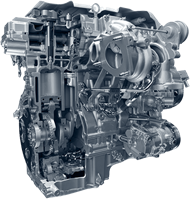When it comes to engines, the terms ‘remanufacturing’ and ‘reconditioning’ are quite often confused within the motor industry, as well as by consumers. As a leading engine remanufacturer for over 70 years, Ivor Searle explains the differences.

Remanufacturing and reconditioning or ‘reman engines’ and ‘recon engines’ are poles apart when it comes to the actual process involved and resulting quality of the product. This includes any major unit, such as a gearbox, turbo or cylinder head, for example.
Put simply, a reconditioned or recon engine is one that has been stripped down either partially or fully, cleaned and possibly had some damaged components replaced prior to being rebuilt.
In contrast, a remanufactured or reman engine has been returned to the vehicle manufacturer’s original factory specification through an extensive, audited process. As a result, remanufactured engines provide levels of performance, reliability and lifespan that are equal to and, in many instances exceed, those of the original. Most importantly, a remanufactured unit is absolutely not a reconditioned or recon engine.
It should be noted that a remanufactured engine is required to meet a specific standard for it to be described as such under BSI AU 257:2002. This is a British Standard Automobile Series Code of Practice that applies to the remanufacturing of internal combustion engines. The standard (which Ivor Searle helped to develop) fully details the procedures and operations for the remanufacturing of both spark (petrol) and compression ignition (diesel) engines.
These processes include the detailed inspection and checking of components against manufacturer tolerances. Key parts, including pistons and ring sets, big and small end bearings and bushes, as well as gaskets, seals, timing chains and drive belts are all required to be renewed, while items such as tensioners and dampers are also required to be inspected and replaced if necessary.
Further important operations, such as intensive cleaning, crack testing machined components and the deburring of reworked oil pathways, are also undertaken to ensure the original specification of the engine is achieved with full reliability. In addition to having all key clearances, tolerances and end floats checked after assembly, the standard also requires complete reman engines to be checked for oil pressure and compression.
Remanufactured engines built by Ivor Searle also offer the additional advantage of having their own unique serial number, which provides an audit trail for all of the components that have been renewed, as well the remanufacturing completion date and test records.
As one of UK’s leading independent engine remanufacturers for over seven decades, Ivor Searle takes the high standard demanded by BSI AU 257:2002 a step further by combining it with a quality management system certified to ISO 9001:2015 to ensure that customers are provided with a consistently high standard of quality, product reliability and service.
Therefore, an engine can only be described as ‘remanufactured’ if it complies with BS AU257:2002. It provides a clear distinction between engines that are professionally remanufactured and those that are classed as inferior recon engines.
To give an idea of the level of detail involved in the reman engine process undertaken by Ivor Searle, here is a list of the mandatory operations and procedures:
Camshaft
- Camshafts are either replaced with a new unit or re-profiled to their original valve timing and lift specifications
Cylinder Head
- Every cylinder head is inspected for cracks
- Engines with OHC configurations have the camshaft bores measured for size, ovality, taper and alignment and are either restored to OEM specification or scrapped
- Valve guides are measured for wear and either resized or renewed to conform to original tolerances
- Valve seats are machined to retain the correct seat angles, widths, valve heights and valve seating concentric with the centre line of the valve guide bore
- Valves are examined for damage, head thickness and stem wear and replaced or machined as necessary
- All valve springs are tested for squareness, free height and compressed load length
- Cylinder heads are checked for distortion and thickness
- When machining the cylinder head face, attention is paid to maintaining the surface finish specified by the gasket manufacturer.
Crankshaft
- After grinding, all crankshafts are polished to produce the exact dimensions and surface finish required.
- Diesel crankshafts are electro-magnetically crack tested
- Seal diameters and nose ends are also measured and, if necessary, reclaimed.
- Blended radii, thrust wear and alignment are also checked
- Oil galleries are de-burred and thoroughly cleaned
Cylinder block
- When re-facing the cylinder block, attention is paid to the surface finish and deck height
- Each cylinder block is re-bored or re-sleeved and honed to give the precise surface finish and cross-hatch required
- All main housings are measured for size, ovality, taper and alignment and machined as required
Con-rods
- Big end housings are measured for size and ovality and are re-sized as necessary
- Small end bushes are measured and replaced if found to be outside OEM specification
- All con-rods are checked for alignment and are weight graded into engine sets
Oil pump
- The clearance between the pump’s body and rotor are measured
- The oil pressure relief valve is dismantled and cleaned and all non-conforming parts are replaced
New components
- All remanufactured engines are equipped with new pistons, piston pins, piston rings, mains and con-rod bearings, timing chain or belt gaskets, oil seals, core plugs and oil filter
- These new components are carefully selected for their durability and reliability and are sourced from the same producers that supply the vehicle manufacturers
- All diesel pumps and injectors are remanufactured to perform to OEM specifications by a diesel injection specialist
Testing
- Every engine is tested in a purpose-built test cell and subjected to a series of checks, the results of which are recorded against each engine’s specific serial number
Filed under: recon engines, recon gearbox, recon turbos, reconditioned engines